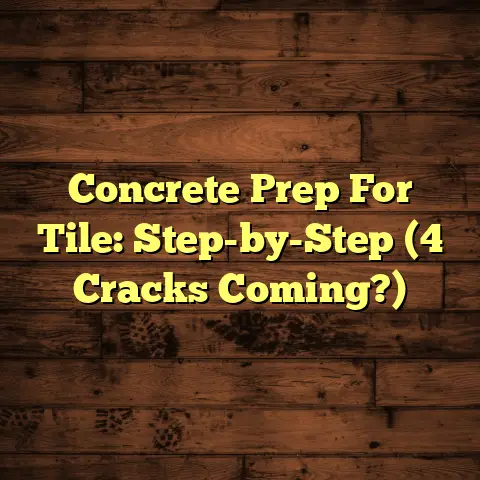How to Level Floor For Shower? (3 Subfloor Secrets!)
As a flooring contractor based in the Pacific Northwest for over 15 years, I’ve seen my fair share of wonky floors.
Trust me, I get it.
You’re dreaming of that spa-like shower, but the thought of tackling your uneven floor is holding you back.
Don’t sweat it!
Leveling a floor for a shower install doesn’t have to be a nightmare.
In fact, with the right know-how, you can nail it like a pro.
Here in the PNW, we battle unique challenges: constant moisture, older homes with settling issues, and basements that sometimes feel like underground springs.
All this can wreak havoc on your subfloor, making a level surface crucial for a long-lasting, leak-free shower.
In this article, I’m going to spill the beans on my top 3 subfloor secrets for leveling a floor like a boss.
We’ll cover everything from assessing your existing subfloor to choosing the right leveling method and those all- important finishing touches.
So, grab your coffee, roll up your sleeves, and let’s get started!
Section 1: Understanding the Importance
of a Level Floor
Okay, let’s talk about why a level floor is non-negotiable for your shower.
When I say “level floor,” I mean a surface that’s perfectly horizontal, with no dips, bumps, or slopes that could cause issues.
Think of it this way: if you were to pour water on a level floor, it would spread out evenly without pooling in any particular spot.
Why Does It Matter?
An uneven floor under your shower base or tiled shower floor is a recipe for disaster, especially in our damp climate.
Here’s what can happen:
-
Water Pooling: Even slight unevenness can cause water to pool, leading to unsightly stains, mold growth, and potential damage to your flooring and walls.
-
Leaks: An uneven surface can compromise the seal between your shower base and the floor, leading to leaks.
Trust me, chasing down a hidden leak is NOT how you want to spend your weekend!
-
Mold Growth: Where there’s water, there’s mold. And mold thrives in the damp environments we often see in the PNW.
Mold not only looks gross but can also cause health problems.
-
Structural Damage: Over time, constant exposure to water can weaken the subfloor and surrounding structures, leading to costly repairs.
-
Fixture Instability: An uneven floor can cause your shower base or tiled floor to be unstable, leading to cracks, chips, and a shorter lifespan.
Think about it – you’re investing good money into your shower.
Don’t let a wonky floor ruin everything!
Leveling the floor ensures that your shower base sits properly, water drains correctly, and your entire bathroom stays dry and healthy.
The Numbers Don’t Lie
According to the EPA, household leaks can waste nearly 1 trillion gallons of water annually nationwide.
Source: EPA Website
And guess what?
A significant portion of those leaks start in the bathroom, often due to improper shower installations caused by uneven floors.
I can’t stress enough how important it is to address the flooring issues before the shower installation.
It will save you a lot of money, time and headache in the long run.
Section 2: Tools and Materials Needed
for Leveling
Alright, let’s gear up!
Before you dive into leveling your floor, you’ll need the right tools and materials.
Here’s my go-to list:
Essential Tools:
-
Level: A good quality level is your best friend. I recommend a 4-foot level for checking larger areas and a smaller torpedo level for tight spots.
-
Measuring Tape: You’ll need to accurately measure distances and determine the extent of the unevenness.
-
Chalk Line: This is handy for creating straight lines and marking areas that need to be leveled.
-
Trowel: For spreading self-leveling compound or thin-set mortar. I prefer a notched trowel for even distribution.
-
Mixing Bucket & Drill with Mixing Paddle: If you’re using self-leveling compound, you’ll need these for proper mixing.
-
Shop Vacuum: Essential for cleaning the subfloor before leveling.
-
Safety Glasses & Gloves: Always protect your eyes and hands!
-
Straight Edge: A long, straight piece of wood or metal can help you identify low spots.
Flooring Materials:
-
Self-Leveling Compound (SLC): This is a liquid mixture that self-levels and creates a smooth, even surface.
It’s great for minor imperfections.
-
Plywood or Cement Board: For more significant unevenness, you might need to add a layer of plywood or cement board.
Cement board is ideal for wet areas like showers.
-
Thin-Set Mortar: Used to adhere cement board to the subfloor.
-
Construction Adhesive: For securing plywood to the subfloor.
-
Wood Shims: Small pieces of wood used to fill gaps and level surfaces.
Choosing the Right Materials for the PNW
Living in the Pacific Northwest, we need to be extra mindful of moisture.
Here are a few tips:
-
Self-Leveling Compound: Choose an SLC that’s specifically designed for wet areas. Look for products that are mold- and mildew-resistant.
-
Cement Board: Cement board is a must for shower floors. It’s waterproof and won’t rot or warp like plywood can.
I recommend using a high-quality cement board like HardieBacker or Durock.
-
Waterproofing Membrane: After leveling and installing your cement board, apply a waterproofing membrane like RedGard or Kerdi to protect your subfloor from moisture penetration.
Pro Tip:
When buying materials, always read the manufacturer’s instructions and choose products that are compatible with each other.
Don’t be afraid to ask for help at your local hardware store.
They can offer valuable advice and recommendations based on your specific project.
Section 3: The Three Subfloor Secrets
for Successful Leveling
Okay, now for the good stuff!
Here are my three subfloor secrets that will help you achieve a perfectly level floor for your shower:
Secret #1: Assessing and Preparing
the Existing Subfloor
Before you start slathering on self- leveling compound, take the time to thoroughly assess and prepare your existing subfloor.
This is the most crucial step!
Step 1: Inspect for Damage
Carefully inspect the subfloor for any signs of damage, such as:
-
Rot: Soft, crumbly wood is a sign of rot. Poke around with a screwdriver to see how extensive the damage is.
-
Water Stains: These indicate past or present leaks. Investigate the source of the leak and fix it before proceeding.
-
Cracks: Cracks can weaken the subfloor and allow moisture to penetrate.
-
Loose or Missing Fasteners: Make sure all screws and nails are securely fastened.
-
Unevenness: Use your level and straight edge to identify low spots, high spots, and slopes.
Step 2: Check Moisture Content
Moisture is the enemy of a healthy subfloor.
Use a moisture meter to check the moisture content of the wood.
Ideally, it should be below 12%.
If it’s higher, you’ll need to address the moisture issue before leveling.
Step 3: Clean the Subfloor
Thoroughly clean the subfloor with a shop vacuum to remove any dust, debris, and loose particles.
This will ensure proper adhesion of your leveling materials.
Step 4: Repair Any Damage
-
Rotten Wood: Remove and replace any rotten wood. Make sure to cut back to solid, healthy wood.
-
Cracks: Fill cracks with wood filler or epoxy.
-
Loose Fasteners: Replace loose or missing screws and nails.
Step 5: Ensure Proper Ventilation
Proper ventilation is crucial for preventing moisture buildup.
Make sure your bathroom has adequate ventilation, either through a window or an exhaust fan.
Pro Tip:
If you’re dealing with extensive damage or moisture issues, it’s best to consult with a professional contractor.
They can assess the situation and recommend the best course of action.
Secret #2: Choosing the Right Leveling Method
Once you’ve prepped your subfloor, it’s time to choose the right leveling method.
Here are the two main options:
Option 1: Self-Leveling Compound (SLC)
SLC is a great option for minor imperfections (less than 1/2 inch).
It’s easy to apply and creates a smooth, even surface.
Here’s how to apply SLC:
-
Prime the Subfloor: Apply a primer to the subfloor to improve adhesion of the SLC. Follow the manufacturer’s instructions.
-
Mix the SLC: Carefully follow the manufacturer’s instructions for mixing the SLC. Use a drill with a mixing paddle to ensure a smooth, lump-free consistency.
-
Pour the SLC: Pour the SLC onto the subfloor, starting in the lowest area.
-
Spread the SLC: Use a trowel to spread the SLC evenly and ensure it covers the entire area.
-
Allow to Cure: Allow the SLC to cure completely before proceeding with your shower installation. Follow the manufacturer’s instructions for curing time.
Option 2: Installing a New Subfloor
For more significant unevenness (greater than 1/2 inch) or extensive damage, installing a new subfloor is the best option.
Here’s how to install a new subfloor:
-
Remove the Existing Subfloor: Carefully remove the existing subfloor, making sure to remove all nails and screws.
-
Install Shims: Use wood shims to level the joists. Secure the shims with construction adhesive.
-
Install Plywood or Cement Board: Cut the plywood or cement board to size and install it over the joists, securing it with screws.
-
Stagger the Seams: Stagger the seams of the plywood or cement board to prevent cracking.
Pros and Cons
| Method | Pros | Cons |
|---|---|---|
| Self-Leveling Compound | Easy to apply, creates a smooth surface, good for minor imperfections | Can be expensive, not suitable for large unevenness |
| Installing a New Subfloor | Good for significant unevenness, addresses structural issues | More labor-intensive, requires more skill, can be more expensive overall |
Choosing the Right Method for the PNW
In the PNW, I generally recommend using cement board for shower subfloors due to its superior moisture resistance.
If you’re using SLC, make sure to choose a product that’s specifically designed for wet areas.
Secret #3: Finishing Touches and
Final Checks
You’ve leveled your floor – awesome!
But don’t get ahead of yourself just yet.
Before you start installing your shower, there are a few finishing touches and final checks you need to take care of.
Step 1: Final Inspection
Carefully inspect the leveled floor for any imperfections.
Use your level and straight edge to check for levelness in all directions.
Step 2: Make Adjustments
If you find any low spots or unevenness, make adjustments as needed.
You can use thin-set mortar to fill in low spots or sand down high spots.
Step 3: Install Underlayment
If you’re installing a tiled shower floor, you’ll need to install an underlayment over the leveled subfloor.
This will provide a smooth, stable surface for your tiles.
Step 4: Waterproofing
This is the MOST important step!
Apply a waterproofing membrane to the leveled subfloor and underlayment.
This will protect your subfloor from moisture penetration and prevent leaks.
I recommend using a liquid waterproofing membrane like RedGard or a sheet membrane like Kerdi.
Step 5: Final Check for Levelness
One last time, check the floor for levelness.
You want to make sure everything is perfect before you start installing your shower.
Pro Tip:
Don’t rush this step!
Taking the time to do a thorough final inspection and make any necessary adjustments will pay off in the long run.
Conclusion
There you have it – my top 3 subfloor secrets for leveling a floor for your shower!
Remember, a level floor is essential for a long-lasting, leak-free shower.
By following these tips and tricks, you can achieve a professional-quality result that will make your bathroom look and function amazing.
Don’t be afraid to tackle this project yourself!
With the right tools, materials, and know-how, you can level your floor like a pro.
And if you ever feel overwhelmed or unsure, don’t hesitate to consult with a professional contractor.
We’re here to help!
So, go ahead, assess your floor, choose your leveling method, and get ready to transform your bathroom into the spa-like oasis you’ve always dreamed of.
Happy leveling!





